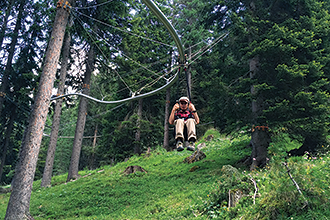ADVENTURE CULTURE
This stop also brought about a third, and probably most striking, observation about the European adventure attraction culture. The weather had started out with clear skies, but it began to cloud up rather quickly. When the eight of us Americans heard the first clap of thunder, we all froze. Would we have to suspend our tour? We asked if we should begin to descend. The question brought strange looks from the other participants and guides, who replied, “I guess, if you’re done…”
European operators are much less sensitive to lightning and thunder, and are less intent on mitigating risk in general. That’s because ownership of risk in Europe is split evenly between the participants and the operator—in stark contrast to the U.S., where the operator assumes the liability for the risk unless a release is signed. In Europe, waivers were few and far between.
Instead, we found ourselves responsible for our own well being at several turns. As we descended on a mountain coaster, for example, it was not uncommon to have to bring our sled to a dead stop so that grazing cows could cross the track. While operators or aerial guides would check our harnesses before we started any activity, we were responsible for putting them on initially.
Despite this staggeringly different cultural norm, there wasn’t a moment when we felt unsafe.

Bahman Azarm of Outdoor Ventures rides the Fly-Line Skycoaster in the Italian Dolomites.
A lesser focus on risk mitigation allows for more experimentation, and many of the attractions we visited appeared to be on the cutting edge of aerial attraction technology. From the monorail mountain cart that rode like an old school wooden roller coaster but was still firmly attached to the rail in Mutters, Austria, to the Fly-Line (think speed-controlled zip coaster) in Fassa, Italy, the technologies being used in Europe surpass most adventure attractions offered in the U.S.
Developers on the east side of the pond tend to be hesitant about bringing these technologies to the States, given the complex approval process in the U.S. and the litigious nature of Americans in general. That said, we are starting to see more and more of these innovations make the leap.
An example of this is the Rope Runner zip line we rode in Stoderzinken, Austria. The Rope Runner utilizes an eddy current braking trolley, as well as an innovative automated launch platform, to provide a zip line experience that is capable of much steeper angles and higher speeds than the standard zip line. The sit-style harness that we wore was like zipping in a recliner at 60 miles per hour! With four parallel lines, we raced to the bottom. We’re not sure how, but Dave, Chris, and I are convinced that Bahman cheated on the first run to take the win.
MARKET QUIRKS
Pricing of adventure park attractions in the European market is markedly lower than in the U.S. Aerial park tickets were between €29 to €35 (about $32 to $38) for adults; long zip line rides were €22 each. The U.S. market is averaging $46 for an adult aerial park ticket, and similar zip rides are around $35 in comparison.
Of course, the European market is more mature than the U.S., and some saturation has taken place due to the abundance of adventure opportunities. The attractions are also often geographically closer to each other than in many other markets, so the laws of supply and demand come into play. The discrepancy in price may also indicate that Americans are simply willing to pay more for a standalone experience than Europeans are.



